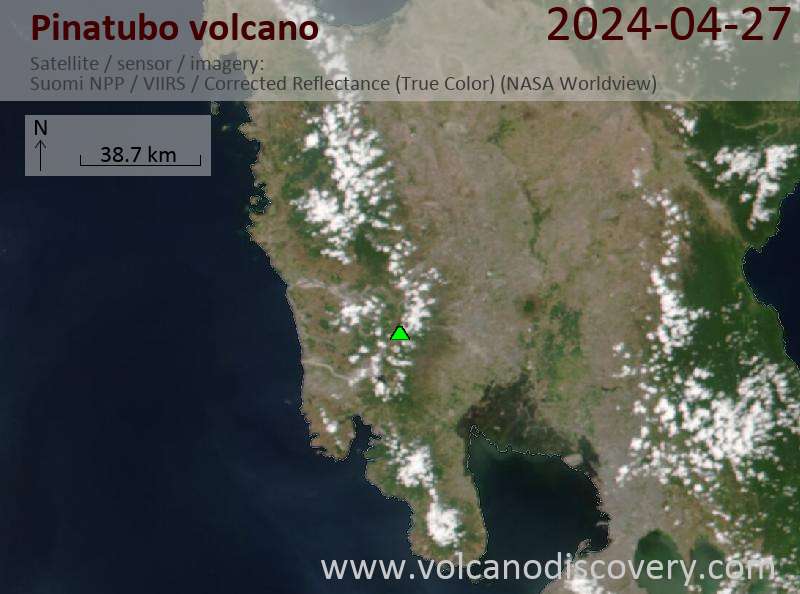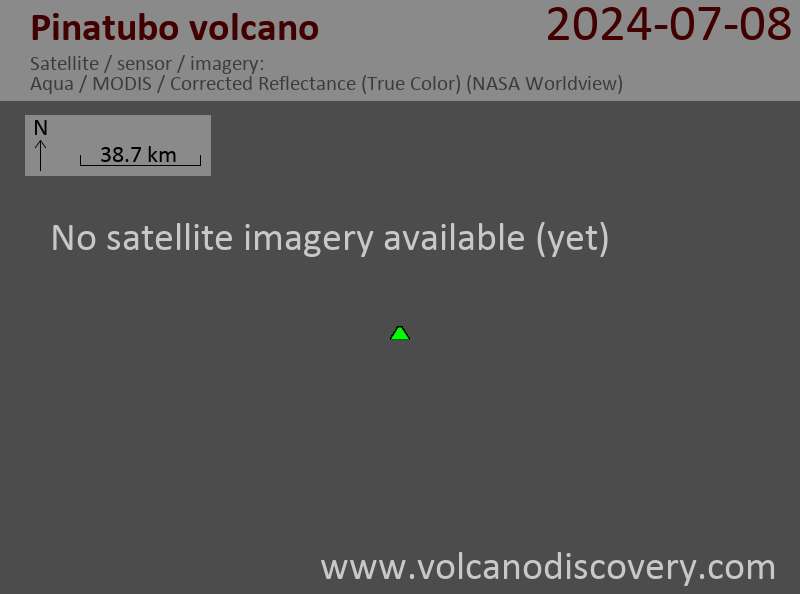When Will Pinatubo Volcano Erupt Again
Pinatubo volcano
stratovolcano 1486 g / 4,875 feet
Luzon Isle (Philippines), 15.13°N / 120.35°E
Current condition: normal or fallow (1 out of 5)
Terminal update: 23 Jan 2022 (Smithsonian / USGS Weekly Volcanic Activity Study)

The June 12, 1991 eruption column from Mount Pinatubo taken from the east side of Clark Air Base. U.S. Geological Survey Photograph taken on June 12, 1991, 08:51 hours, by Dave Harlow.
Pinatubo volcano exploded spectacularly on 15 June 1991. The Pinatubo eruption on fifteen June 1991 was the 2d largest volcanic eruption of the 20th century.
Pinatubo is a complex of lava domes located 100 km NW of Manila urban center, Luzon Island, Philippines.
Prior to the eruption, Pinatubo was a little known volcano and information technology had been dormant for 400 years. There were no known historic eruptions. Earlier the eruption in 1991 Pinatubo was 1745 g high (ca. 250 m more now), and was only 200 m higher than the nearby peaks, which are remnants of older volcanic edifices of Mt Pinatubo and hid it from views from distance. Pinatubo mostly noted for a failed geothermal evolution project.
Eruptions of Mount Pinatubo
Pinatubo has had at to the lowest degree vi periods of activity with large explosive eruptions in its past 35,000 years prior to the 1991 eruption. The 1991 eruption in this context actually ranks as one of the smaller eruptions. An eruption, which occurred 35,000 years ago and probably created the caldera, was likely much bigger.
Typical eruption mode: explosive
Pinatubo volcano eruptions: 2021?, 1992, 1991 (Plinian eruption), 1450 ± 50 years, 1050 BC ± 500, 3550 BC (?), 7030 BC ± 300, 7460 BC ± 150, 15,000 BC, 33,000 BC
Lastest nearby earthquakes:
| Fourth dimension | Magazine. / Depth | Distance/Location | ||
| Tuesday, March 29, 2022 GMT (3 quakes) | ||||
| Mar 30, 2022 2:55 am (GMT +viii) (Mar 29, 2022 18:55 GMT) | iv.8 47 km | 60 km (37 mi) Virtually Quezon City, National Capital Region, Philippines | ||
| Mar 30, 2022 2:46 am (GMT +viii) (Mar 29, 2022 18:46 GMT) | ii.seven 9 km | 56 km (35 mi) Philippines: 026 Km Due south 67° Westward of Cabangan (Zambales) | ||
| Mar xxx, 2022 2:26 am (GMT +8) (Mar 29, 2022 18:26 GMT) | 3.6 7 km | 65 km (40 mi) Philippines: 034 Km S 75° West of Cabangan (Zambales) | ||
Background
Geology of Mt Pinatubo volcano
Regional setting:
Pinatubo is flanked to the west and probably underlain past by the Zambales Ophiolite Complex, an easterly-dipping department of Eocene oceanic chaff which was uplifted in the late Oligocene.
The 2d unit are sediments of the Tarlac Formation, mostly sandstone and siltstone in the older parts, and conglomerates and volcanic sediments and dikes in the younger. The Tarlac formation is found in the north, east and southeast of Pinatubo and formed contemporary with the oldest known volcanic centers in the area, including Mountain Mataba or the diorite of the Dizon Mine, the sub-surface remnant of an ancient vent.
The ancient volcanoes of the Tarlac Formation originated from the same east-dipping subduction along the Manila trench that continues to the nowadays.
Aboriginal Pinatubo:
Pinatubo was formed in 2 stages. The bequeathed Pinatubo started to form virtually i million years agone, and built an andesite - dacite stratovolcano whose center was at the same location as today. Remnants of this precessor are seen in the aboriginal 3.5x4.five wide caldera. Ancient Pinatubo had a number of flank vents, that formed the domes of Mount Negron, Mount Cuadrado, Mataba, Bituin plug, and the volcanic plug of Tapungho.
Deep erosion in the Sacobia, Porac, Marimla, and Porac River valleys, and weathering of the lavas suggests that activeness of the bequeathed volcano ended several tens of thousands of years (or more) before the caldera-forming eruption and initial growth of the modernistic Pinatubo (ca. 35,000 years ago).
Modernistic Pinataubo:
After the 1991 eruption, scientists (mainly from PHILVOLCS & USGS) carried out intensive fieldwork on the deposits of nowadays-day Pinatubo to analyze its eruptive history. They distinguished at least half dozen eruptive periods of modern Pinatubo, characterized by repeated, big explosive eruptions:
Inararo Eruptive Menstruum -- >35,000 14C yr B.P.
The largest eruption in the history of modern Pinatubo occurred 35,000 (radiocarbon) years ago. Information technology deposited up to 100 m or more than of pumice and ash flows on all sides of Mountain Pinatubo.
Sacobia Eruptive Menses -- ~17,000 year B.P.
A phase of explosive eruptions occurred 17,000 years ago and produced 2 debris flow deposits which are visible on the north bank of the Sacobia River.
Pasbul Eruptive Period -- ~nine,000 yr B.P.
A large explosive eruption occurred ca. 9000 years ago. It produced pyroclastic-menstruation and tephra-fall layers exposed forth the road between Sitio Pasbul, Camias, Porac, and the Gumain River. The pyroclastic flows overtopped the southeastern rim of the Tayawan caldera and about or completely filled the valley of the Gumain River.
Crow Valley Eruptive Flow -- ~half dozen,000-5,000 twelvemonth B.P.
Large eruptions 6,000-5,000 years ago produced pyroclastic menstruation deposits on both sides of upper Crow valley.
Maraunot Eruptive Menstruation -- ~3,900(?)-2,300 yr B.P.
Eruptions in this period produced pyroclastic flows and lahars.
Buag Eruptive Period -- ca. 1450 Advertisement
The last activity bicycle prior to the 1991 eruption was in 1450 ± 50 AD. It produced pyroclastic flows that entered all valley of Pinatubo except the Gumain and Porac rivers.
-------------
Sources of information
The most comprehensive information about Pinatubo volcano is nerveless in 62 scientific papers in the following volume:
- Newhall et al (1996) "Eruptive history of Mount Pinatubo", in NEWHALL, C.M. and PUNONGBAYAN, R.K. (eds.) (1996) "FIRE AND MUD: ERUPTIONS AND LAHARS OF MOUNT PINATUBO, PHILIPPINES", Philippine Institute of Volcanology and Seismology (PHILVOLCS) / USGS / University of Washington Printing (online at pubs.usgs.gov/pinatubo/index.html)
- GVP Pinatubo volcano information
- Mount Pinatubo, Philippines USGS / CVO website most Pinatubo
-------------
Pinatubo Aeta people
The forested expanse of Pinatubo mountain was also known as abode for a tribe of the Aeta people,- the small, dark skinned, and kinky haired people believed to be the nearest descendants of the original inhabitants of the Philippines, who arrived through land bridges that linked the Philippines with the Asian mainland some 30,000 years ago. They considered the mountain the dwelling of Apo Namalyari, the Great Protector and Provider. (Source: CCP Encyclopedia of Arts)
2009 earthquake & lahars
On 31 October 2009 a magnitude 5.0 tectonic earthquake with a depth of 79 km hit 37 km WSW of the top of Pinatubo volcano.
Heavy monsoon rains caused by draft Kiko generated heavy floods in August 2009. 12 people were killed in the town of Botolan in Baronial 2009.
2001-2004: caldera lake changes
During 2001 the caldera lake on Mt Pinatubo rose to dangerous levels and the water changed color in January 2004.
1991 Plinian eruption of Pinatubo - the 2nd largest in the 20th century
The June 15, 1991 eruption was probably the second largest explosive eruption of the 20th century, second in size only to the Katmai 1912 eruption in Alaska. Information technology was about 10 times larger than the eruption of Mount St. Helens in 1980.
->Chronology of the 1991 eruption ...more than


See likewise: Sentinel hub | Landsat eight | NASA FIRMS
First visit to our site? If you havn't done it all the same, download the Volcanoes & Earthquakes app to get one of the fastest volcano news online:
Android | IOS
Source: https://www.volcanodiscovery.com/pinatubo.html
0 Response to "When Will Pinatubo Volcano Erupt Again"
Post a Comment